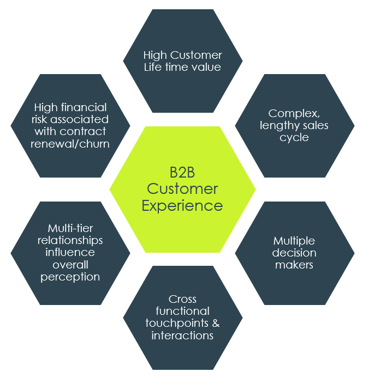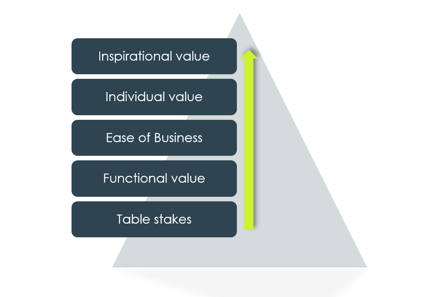1 min read
Gathering Omni-Channel Feedback – What Response Rates Can You Expect?
Providing customers with an omni-channel experience is important for optimising the customer interactions and increasing the accuracy and depth of...
4 min read
 Sarah Lubbe
:
02 September 2020
Sarah Lubbe
:
02 September 2020

For many years, CX and Customer Feedback has found a firm place within the B2C environment, with many B2B organisations eschewing formalised feedback programmes. For the most part, the reason for the lower uptake within B2B industries was that there was a long-held assumption that retention and customer relationships happened organically thanks to account management and the like. In recent years, however, it has become clear, that particularly in large, complex B2B organisations, there is a definite need to formalise the understanding of customer feedback. The adoption of both structured customer departments, CX strategy and indeed, technology-driven mechanisms to gather feedback from customers is ever increasing.
Why is B2B CX so complex?
 From the length of the sales process, educated users, multiple decision-makers, thorough vetting before conversion and larger stakes on account renewal and customer continuity, managing customer experience within a B2B environment is far more complex and nuanced than within the B2C environment. At the same time, however, the value of CX within a B2B environment is exponentially more valuable. The B2B ecosystem offers a higher customer lifetime value (CLV) as compared to the B2C industry, given that the price of products/services are much more. This means the value of potential business per customer, is much more and thus, cultivating great customer relationships by consistently providing great CX is critical to sustained success in the B2B world,
From the length of the sales process, educated users, multiple decision-makers, thorough vetting before conversion and larger stakes on account renewal and customer continuity, managing customer experience within a B2B environment is far more complex and nuanced than within the B2C environment. At the same time, however, the value of CX within a B2B environment is exponentially more valuable. The B2B ecosystem offers a higher customer lifetime value (CLV) as compared to the B2C industry, given that the price of products/services are much more. This means the value of potential business per customer, is much more and thus, cultivating great customer relationships by consistently providing great CX is critical to sustained success in the B2B world,
Creating B2B moments of truth
Within a B2B environment, both the sales and retention processes are far longer and more complex than in a B2C relationship. Consider for a moment an individual making a shoe purchase from a store as opposed to a corporate entering into a 36-month contract. The processes may both look relatively linear and straightforward, but within the B2B environment, the number of interactions, stakeholders, value and processes involved make it challenging.

From a CX point of view, the last to stages within this process can get really messy. The usage stage may span years and involve multiple levels within a client organisation - where people change roles, strategy shifts and the relative value offered to the client is continually evaluated. More often than not, the highest risk within a B2B customer relationship is during the renewal phase. During this stage, particularly with high-value contracts, the decision-makers are often very far removed from the Day-to-Day usage of a service. More often than not, this dynamic comes into play when B2B organisations have adopted transactional feedback mechanisms to understand the functional value. Still, by lagging on relational feedback, there are either weaker relationships with decision-makers or missing value for the less obvious players in the buyer's pool.
Managing the buyer pool
 That brings us quite neatly to the next driver of complexity, that of a stakeholder pool. Different from B2C relationship, with 1 to 1 relationships between brand and buyer, in B2B, there are stakeholder groups– all of whom have differing relationships with the service. For example, Decision Makers typically seek strategic value-adding experiences from the brand when compared to Day -to-Day users who require functionality and ease of usage. The other two groups are auxiliary users and influencers, who often a tad removed from the actual decision and usage roles. Still, these stakeholders bring high impact into the relationship, particularly at renewal, and thus should not be overlooked. An excellent example of an auxiliary user is the procurement team, and for the most part, this stakeholder group is mostly overlooked when it comes to relationship management.
That brings us quite neatly to the next driver of complexity, that of a stakeholder pool. Different from B2C relationship, with 1 to 1 relationships between brand and buyer, in B2B, there are stakeholder groups– all of whom have differing relationships with the service. For example, Decision Makers typically seek strategic value-adding experiences from the brand when compared to Day -to-Day users who require functionality and ease of usage. The other two groups are auxiliary users and influencers, who often a tad removed from the actual decision and usage roles. Still, these stakeholders bring high impact into the relationship, particularly at renewal, and thus should not be overlooked. An excellent example of an auxiliary user is the procurement team, and for the most part, this stakeholder group is mostly overlooked when it comes to relationship management.
One's garbage is another's treasure
 The third layer of complexity is that of the definition of value, and what this means is that each stakeholder persona has a differing requirement from the service at any given stage of the buyer's journey. For example, during the usage phase, Day-to-day users seek functional value - in other words, does this product do what I need it to do. These stakeholders tend to move higher into the individual value definition over time – in other words, is this product enabling me to be a success.
The third layer of complexity is that of the definition of value, and what this means is that each stakeholder persona has a differing requirement from the service at any given stage of the buyer's journey. For example, during the usage phase, Day-to-day users seek functional value - in other words, does this product do what I need it to do. These stakeholders tend to move higher into the individual value definition over time – in other words, is this product enabling me to be a success.
Decision-making buyers, however, tend to start at the individual value tier. If they move upward to inspirational value, they begin to have a personal affinity to the brand, which creates real stickiness. The danger here is if decision-makers are only receiving functional value or table stakes. This is when a B2B relationship considered to be that of a service provider and buyer, not partnership. These levels of value can be understood through mechanisms such as relational studies, where definitions of value can be tested.
Many to many
The last, and perhaps most crucial driver of complexity within B2B CX, is linked to the fact that a B2B relationship is not one to one, but many to many. Essentially, this means that customer satisfaction is wholly driven by teams of people employed within the B2B environment. This additional element of complexity means that in much the same way as customers, employees follow an "employment journey" and have different value expectations from their employer. Not only do successful organisations need to create a cultural affinity between themselves and their employees, but they also need to understand their employee experience in conjunction with their customer experience. Furthermore, every customer experience is often the result of the internal value chain, with vital value-creating interactions happening along the chain, long before the end product is delivered to the customer. Such interactions need to be understood through an experience lens to ensure that the when feedback is ultimately gathered from the customers – these interactions have been value-creating, not eroding.
B2B involved people, Afterall….
According to a recent Mckinsey study "B2B customer-experience index ratings significantly lag behind those of retail customers. B2C companies typically score in the 65 to 85 percent range, while B2B companies average less than 50 percent. What is changing is the realisation that while B2B relationships are complex, they involve individual people, who require great experiences to remain satisfied."
Ideally, B2B organisations should adopt a 3-pronged approach – measuring satisfaction on a transactional level, understanding the customer on a relational level and measuring employee experience. For those just beginning to understand their B2B relationships, periodic relational feedback from key buyer persona's is a good starting point.

1 min read
Providing customers with an omni-channel experience is important for optimising the customer interactions and increasing the accuracy and depth of...

As part of our 11-part trend series, we take a deeper look at AI-powered CX and explore how businesses can implement this trend to enhance their...

The past year has made the world re-evaluate – not only what is important, but also how we do everything from schooling and shopping, through to the...